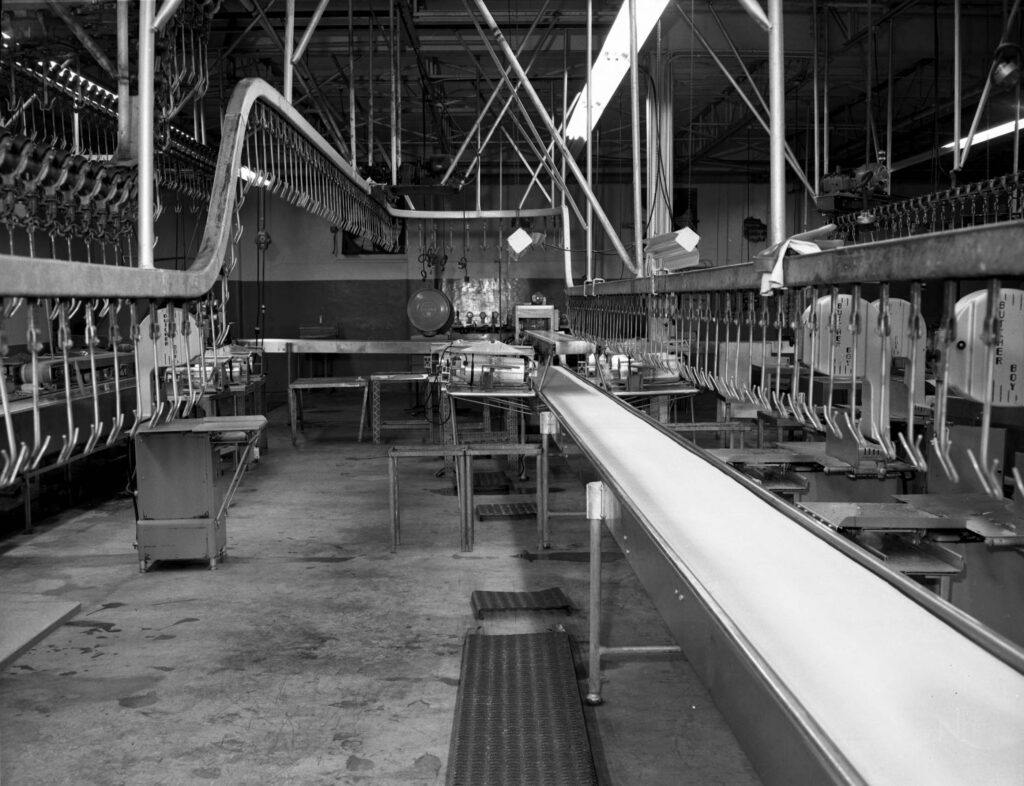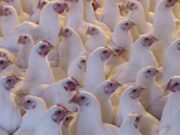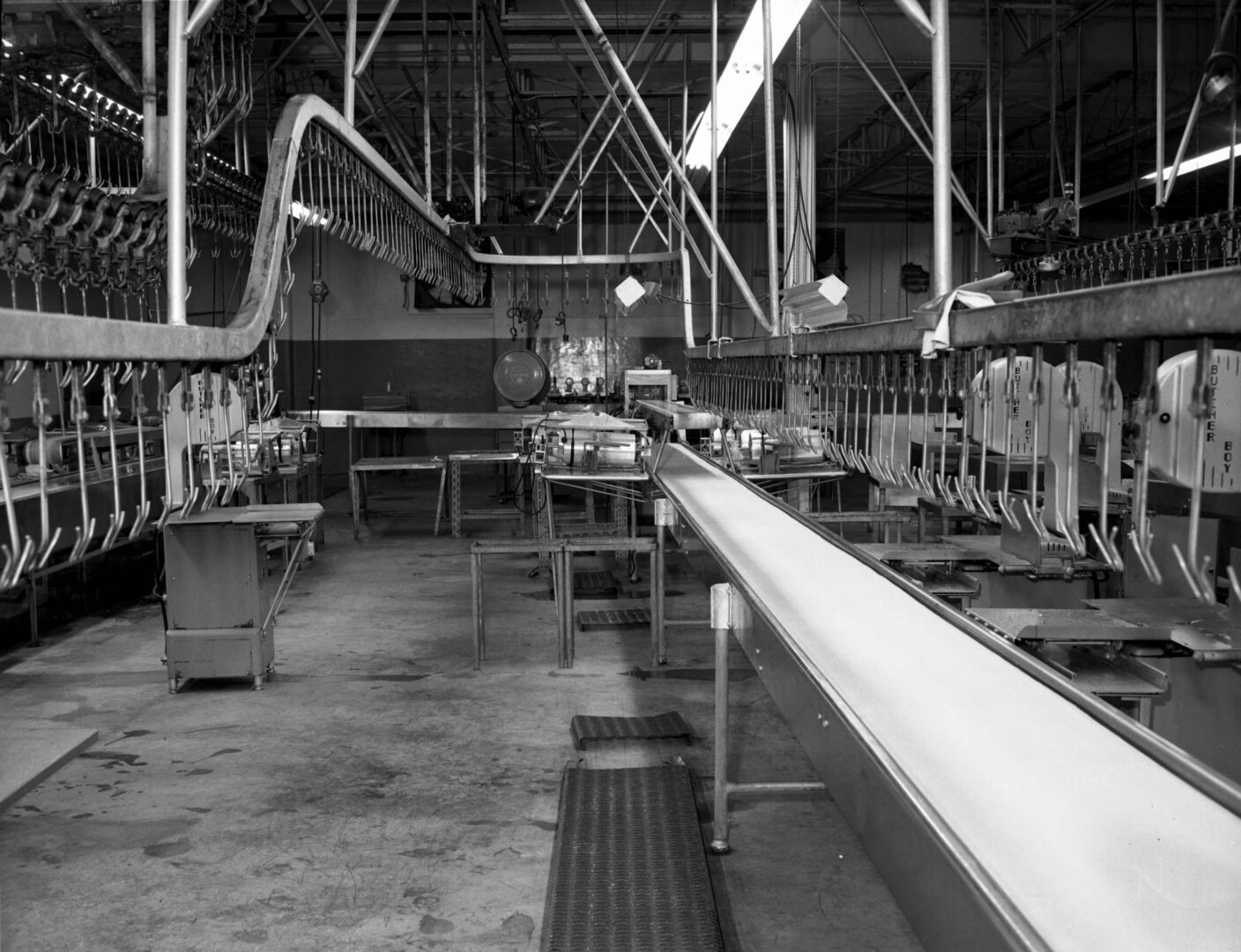The Georgia poultry industry is a highly mechanized production complex that markets chicken and egg products around the globe. On the average day in 2012, Georgia produced 29 million pounds of chicken and 11.8 million eggs.
Major poultry processors based in Georgia include Gold Kist, Fieldale Farms, Claxton, Mar-Jac, and Cagle’s. These vertically integrated companies combine all the phases of the business—raw materials, processing, and distribution—within a single company. Although based elsewhere, a number of other poultry companies also operate in Georgia, including Tyson, Con-Agra, and Continental Grain. Poultry products, including turkeys, earn more than any other Georgia crop, and the statewide economic impact of the industry is an estimated $28 billion annually. The USA Poultry and Egg Export Council is located in Stone Mountain.
Early History
In the early twentieth century chickens in Georgia were raised primarily for their eggs. Gradually, farm women began to market their eggs and chickens on a bigger scale. By 1924 north Georgia chickens were sold out of state by rail. Even before the devastating 1929 stock-market crash, the 1920s were a disaster for most Georgia farmers. Then, in the 1930s, along came a Gainesville feed salesman named Jesse Jewell, who offered north Georgia farmers a deal: he would sell them baby chicks and feed on credit. When the chicks were grown, Jewell’s company, J. D. Jewell, would buy back the adult chickens (broilers) at a price that would cover his costs and guarantee farmers a profit. Once Jewell signed on enough farmers to produce broilers for him, he invested in his own processing plant and hatchery.
World War II: Turning Point
World War II (1941-45) accelerated the growth of the Georgia poultry industry. The War Food Administration reserved all the processed chicken in north Georgia, and thus the Jewell company and others now had a guaranteed buyer. The war also spurred a shift from “New York dressed” (that is, with head, feet, and entrails intact) to fully processed chickens (without head, feet, and entrails), and later to frozen birds, which became the industry standard. Jewell’s addition of a feed mill and rendering plant in 1954 completed the vertical integration of his company. Jewell’s example was repeated by other Georgia poultry entrepreneurs, such as D. W. Brooks of Gold Kist.

Courtesy of Georgia Archives.
The Chicken Boom
After World War II it seemed that everyone in north Georgia was getting into the chicken business. In Hall County the number of farms that raised mainly chickens rose from 57 to 1,044 between 1939 and 1950. Poultry production soared in the 1970s and 1980s as Americans consumed less red meat and more chicken. By 1995 Georgia annually processed more than 5 billion pounds of chicken. In 1998 Georgia emerged as the top broiler-producing state in the country, and in 2012 the state continued to rank first in production of broilers and second in production of chicken eggs.
Many Georgia residents credit the chicken boom with turning parts of the countryside green again, since chicken manure (litter) is an excellent fertilizer. Others point to the harmful environmental impacts of the industry—from fly infestation to polluted water—or to the chicken industry’s controversial “contract farming” system, which makes farmers dependent on large companies and subject to unpredictable price changes. The potential construction of a new poultry-industry facility has caused controversy in a number of Georgia communities.
Chicken Geography
Since the poultry industry sprouted from Hall County roots in the 1930s, production has been concentrated in north Georgia. In 1997 twenty-six of the thirty-two Georgia counties that produced more than 10 million broilers each were located in the northern half of the state. The top producer, Franklin County, and neighboring Banks, Habersham, Hall, Jackson, and Madison counties produced more than a quarter of the state’s total broilers. Processing plants, feed mills, and hatcheries dot north Georgia. At the same time, the poultry industry spans nearly the entire state. About three-quarters of all Georgia counties commercially produce chicken, and the 10-million-plus group includes Tattnall County, in south Georgia.
Poultry production is also moving increasingly south, where land is cheaper and more plentiful and as cooling technology has been improved to cope with the hot summers of south Georgia. As of 2002 south Georgia’s share of 10-million-plus counties rose from less than 20 percent to 35 percent. Long-established Claxton Poultry in Evans County is only the first of a growing number of processing plants in south Georgia. Others include Tyson plants in Buena Vista, Dawson, Oglethorpe, and Vienna; Cagle’s in Camilla; and Gold Kist in Douglas. In May 2004 Mississippi-based Sanderson Farms announced that it would build a new poultry production complex on sites in Cook and Colquitt counties.
Labor
To convert live chickens into a saleable product, companies have employed workers in processing plants, hatcheries, feed mills, and chicken-catching crews. Initially, the plants employed mostly rural white women and some African Americans, as well as white farmers and construction workers during the off-season. Though processing work allowed farm women to earn a cash income, the pay was low and the work highly repetitive, unhealthy, and dangerous. In some Gainesville plants in the early 1970s, annual employee turnover rates approached 400 percent.

Courtesy of Special Collections & Archives, Georgia State University Library.
Conditions in some plants led to attempts at unionization. In the early 1950s a majority of workers at J. D. Jewell voted for representation by the Amalgamated Meat Cutters and Butcher Workmen, though violent attacks on union representatives pushed back the union drive. At Mar-Jac, in Gainesville, workers secured a union contract. Several other north Georgia plants were unionized, and truck drivers at several Gainesville feed mills signed up with the Teamsters Union.
The Contract System
Chicken growing in Georgia has changed dramatically since the 1930s. Due to improving technology, advances in poultry science, and the need for constant refinancing to modernize chicken houses, the number of growers has shrunk. In Hall County only one-sixth of the number of contract growers in 1950 produced six times as many chickens in 1997.
Whereas early agreements were often verbal, everything now revolves around a detailed written contract, applied to one flock of birds at a time. According to the Georgia Poultry Federation, the average return on investment while growers are paying off their mortgages ranges from 4.5 to 7 percent. But there is no guarantee that an integrator will continue to contract with growers. The resulting insecurity has led Georgia growers to band together to bolster their bargaining power with the integrators. North Georgia growers formed the Georgia Contract Poultry Growers Association. In south Georgia growers joined the United Poultry Growers Association.
Globalization
In the 1950s Georgia companies began turning to exports to contend with overproduction and the need to sell a surplus of dark meat. They initially succeeded in Germany, but after a disastrous trade war, integrators turned to Latin America, Asia, and the Middle East. Later, Georgia companies began exporting to the former Soviet Union and China. In 2014 Georgia exported poultry worth around $703 million, more than any other state.
In the 1980s Georgia’s chicken processors turned to a new source of labor: migrants from Latin America. During the 1990s the Latino population of Georgia increased by 300 percent. In the same period Hall County’s Latino population grew by nearly 500 percent. By the opening of the new millennium, the overwhelming majority of production workers in Georgia’s processing plants were immigrants from Latin America, mainly from Mexico. To integrators, these workers appeared to provide a more stable, reliable work force, and turnover rates dropped. For immigrant workers, poultry plants provided unheard-of high wages and benefits.
Because of its global reach in the twenty-first century, the Georgia poultry industry is intimately tied to the world economy and international politics, exposing the state’s industry to new risks and pressures. The Russian ban on chicken imports in March 2002, for example, hit Georgians hard. More recently, China’s 2015 ban on American poultry and egg imports due to health concerns threatens to economically damage Georgia’s poultry farmers.
From its humble barnyard beginnings, the Georgia poultry industry has grown immensely. By 2006 the industry directly employed more than 51,000 Georgians, with another 50,000 state residents working indirectly for the industry—at the University of Georgia, the Georgia Institute of Technology, pharmaceutical companies, equipment suppliers, and county agricultural extension offices.







